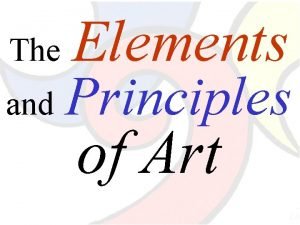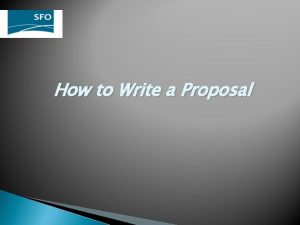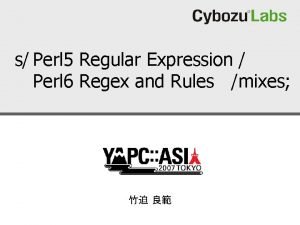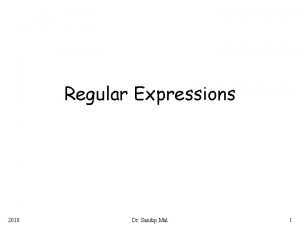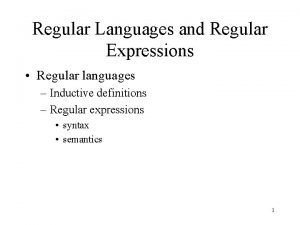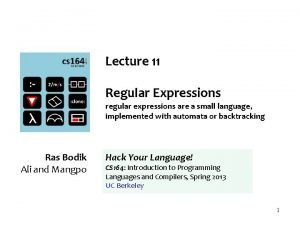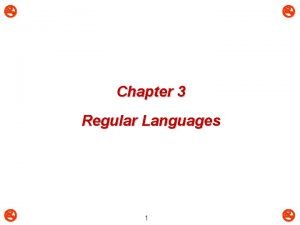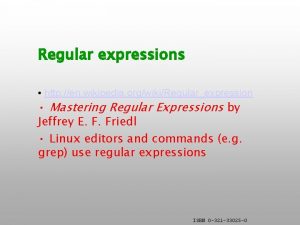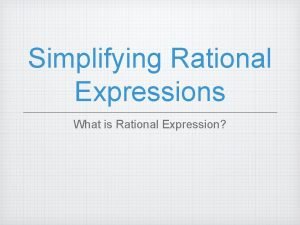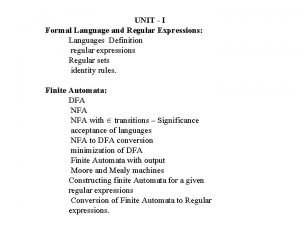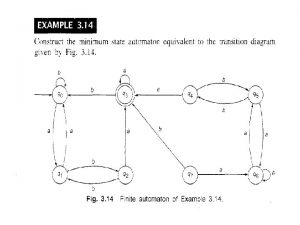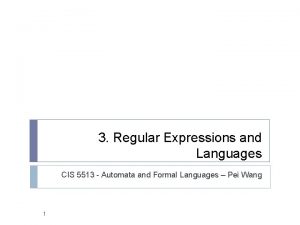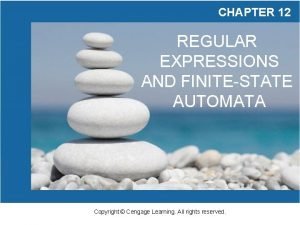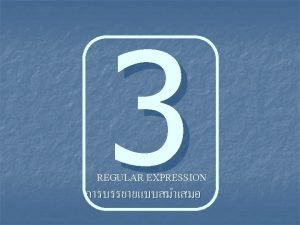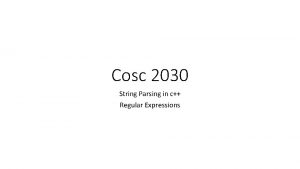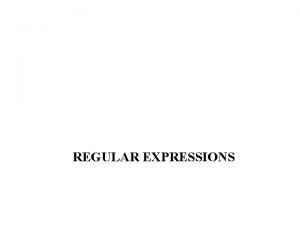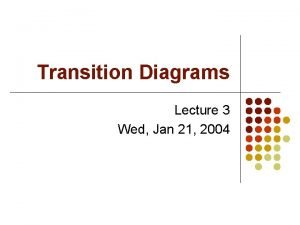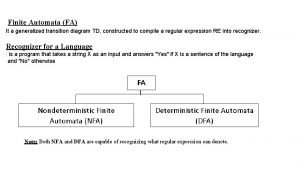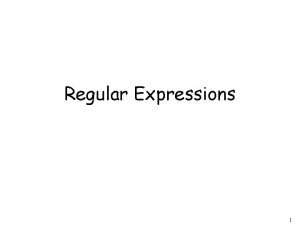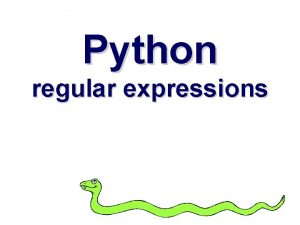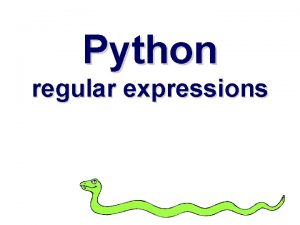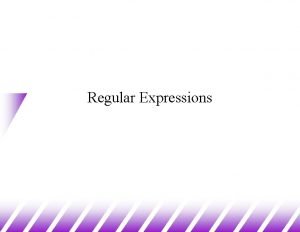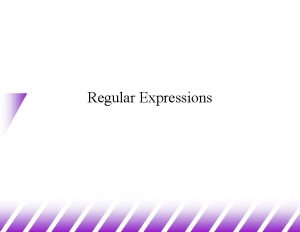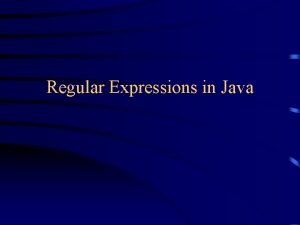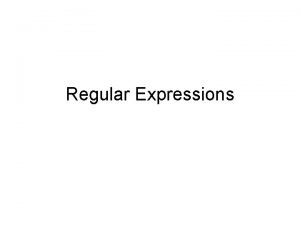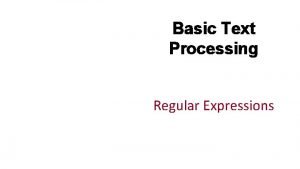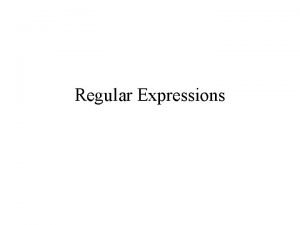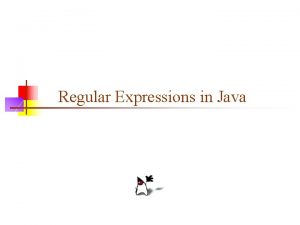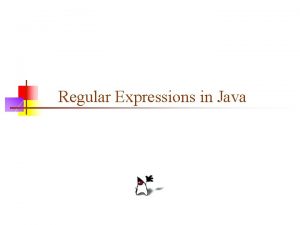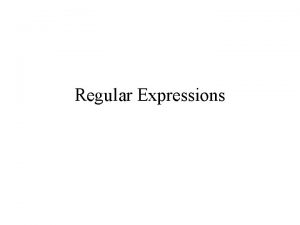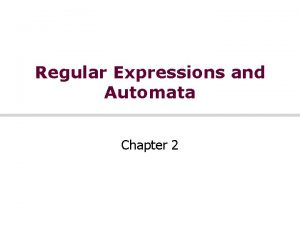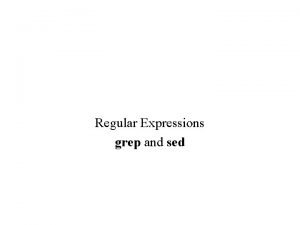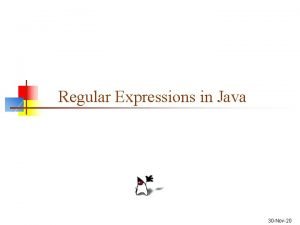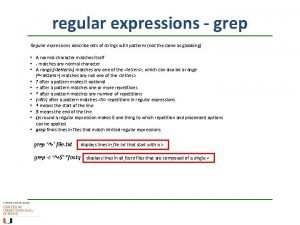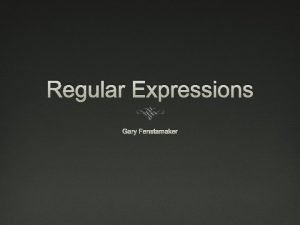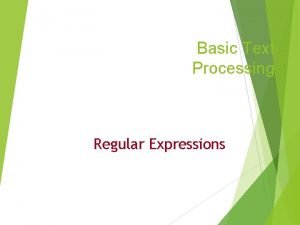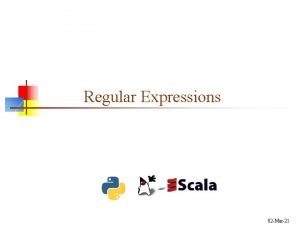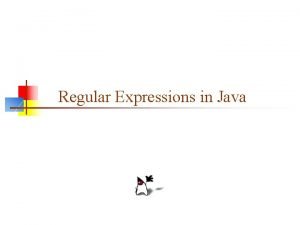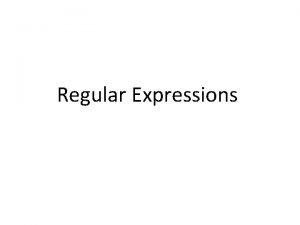Regular Expressions Highlights A regular expression is used


































- Slides: 34

Regular Expressions • Highlights: – – A regular expression is used to specify a language, and it does so precisely. Regular expressions are very intuitive. Regular expressions are very useful in a variety of contexts. Given a regular expression, an NFA-ε can be constructed from it automatically. – Thus, so can an NFA be constructed, and a DFA, and a corresponding program, all automatically! 1

Two Operations • Concatenation: – – – • Language Concatenation: L 1 L 2 = {xy | x is in L 1 and y is in L 2} – – – • x = 010 y = 1101 xy = 010 1101 L 1 = {01, 00} L 2 = {11, 010} L 1 L 2 = {01 11, 01 010, 00 11, 00 010} Language Union: – – L 1 = {01, 00} L 2 = {01, 11, 010} – L 1 UL 2 = {01, 00, 11, 010} 2

Operations on Languages • Let L, L 1, L 2 be subsets of Σ* • Concatenation: L 1 L 2 = {xy | x is in L 1 and y is in L 2} • Concatenating a language with itself: L 0 = {ε} Li = LLi-1, for all i >= 1 3

Kleene closure Say, L, or L 1 ={a, abc, ba}, on Σ ={a, b, c} Then, L 2 = {aa, aabc, aba, abcabc, abcba, baabc, baba} L 3= {a, abc, ba}. L 2 …. . But, L 0 = {ε} Kleene closure of L, L* = {ε, L 1, L 2, L 3, . . . } 4

Operations on Languages • Let L, L 1, L 2 be subsets of Σ* • Concatenation: L 1 L 2 = {xy | x is in L 1 and y is in L 2} • Union is set union of L 1 and L 2 • Kleene Closure: L* = Li = L 0 U L 1 U L 2 U… • Positive Closure: L+ = Li = L 1 U L 2 U… • Question: Does L+ contain ε? 5

Definition of a Regular Expression • Let Σ be an alphabet. The regular expressions over Σ are: – Ø – ε – a Represents the empty set { } Represents the set {ε} Represents the set {a}, one string of length 1, for any symbol a in Σ Let r and s be regular expressions that represent the sets R and S, respectively. – – • r+s rs r* (r) Represents the set R U S Represents the set R* Represents the set R (precedence 3) (precedence level 2) (highest precedence, level 1) (not an operator, rather provides precedence) If r is a regular expression, then L(r) is used to denote the corresponding language. 6

• Examples: Let Σ = {0, 1} (0 + 1)* 01* All strings of 0’s and 1’s 0 followed by any number 1’s 0(0 + 1)* All strings of 0’s and 1’s, beginning with a 0 (0 + 1)*1 All strings of 0’s and 1’s, ending with a 1 (0 + 1)*0(0 + 1)* All strings of 0’s and 1’s containing at least one 0 (0 + 1)*0(0 + 1)* All strings of 0’s and 1’s containing at least two 0’s (0 + 1)*01*01* All strings of 0’s and 1’s containing at least two 0’s (1 + 01*0)* All strings of 0’s and 1’s containing an even number of 0’s 1*(01*01*)* All strings of 0’s and 1’s containing an even number of 0’s (1*01*0)*1* (0+1)* = (0*1*)* All strings of 0’s and 1’s containing an even number of 0’s Any string, or (sigma)*, sigma={0, 1} in all cases here 7 • Question: Is there a unique minimum regular expression for a given language?

• Identities: 1. 2. 3. 4. 5. 6. 7. 8. 9. 10. 11. 1. Øu = uØ = Ø Like multiplying by 0 εu = uε = u Like multiplying by 1 Ø* = ε L* = Li = L 0 U L 1 U L 2 U… ε* = ε = { ε} u+v = v+u u+Ø=u u+u=u u* = (u*)* u(v+w) = uv+uw [which operation is hidden before parenthesis? ] (u+v)w = uw+vw (uv)*u = u(vu)* [note: you have to have a single u, at start or end] [note (uv)* =/= u*v*] (u+v)* = (u*+v)* = u*(u+v)* = (u+vu*)* = (u*v*)* = u*(vu*)* = (u*v)*u* 8

Equivalence of Regular Expressions and NFA-εs • Note: Throughout the following, keep in mind that a string is accepted by an NFA-ε if there exists ANY path from the start state to any final state. • Lemma 1: Let r be a regular expression. Then there exists an NFA-ε M such that L(M) = L(r). Furthermore, M has exactly one final state with no transitions out of it. • Proof: (by induction on the number of operators, denoted by OP(r), in r). 9

Basis: OP(r) = 0 Then r is either Ø, ε, or a, for some symbol a in Σ For Ø: q 0 qf For ε: qf For a: q 0 a qf 10

Inductive Hypothesis: Suppose there exists a k 0 such that for any regular expression r where 0 OP(r) k, there exists an NFA-ε such that L(M) = L(r). Furthermore, suppose that M has exactly one final state. Inductive Step: Let r be a regular expression with k + 1 operators (OP(r) = k + 1), where k + 1 >= 1. Case 1) r = r 1 + r 2 Since OP(r) = k +1, it follows that 0<= OP(r 1), OP(r 2) <= k. By the inductive hypothesis there exist NFA-ε machines M 1 and M 2 such that L(M 1) = L(r 1) and L(M 2) = L(r 2). Furthermore, both M 1 and M 2 have exactly one final state. Construct M as: ε q 0 q 1 M 1 f 1 ε ε ε q 2 M 2 qf f 2 11

Case 2) r = r 1 r 2 Since OP(r) = k+1, it follows that 0<= OP(r 1), OP(r 2) <= k. By the inductive hypothesis there exist NFA-ε machines M 1 and M 2 such that L(M 1) = L(r 1) and L(M 2) = L(r 2). Furthermore, both M 1 and M 2 have exactly one final state. Construct M as: q 1 Case 3) ε f 1 M 1 q 2 M 2 f 2 r = r 1* Since OP(r) = k+1, it follows that 0<= OP(r 1) <= k. By the inductive hypothesis there exists an NFA-ε machine M 1 such that L(M 1) = L(r 1). Furthermore, M 1 has exactly one final state. ε Construct M as: q 0 ε q 1 M 1 f 1 ε qf 12 ε

• Example: r = 0(0+1)* r = r 1 r 2 r 1 = 0 r 2 = (0+1)* r 2 = r 3 * q 0 1 q 1 r 3 = 0+1 r 3 = r 4 + r 5 r 4 = 0 r 5 = 1 13

• Example: r = 0(0+1)* r = r 1 r 2 r 1 = 0 r 2 = (0+1)* r 2 = r 3 * q 0 1 q 2 0 q 1 r 3 = 0+1 r 3 = r 4 + r 5 q 3 r 4 = 0 r 5 = 1 14

• Example: r = 0(0+1)* r = r 1 r 2 r 1 = 0 r 2 = (0+1)* r 2 = r 3 * r 3 = 0+1 r 3 = r 4 + r 5 ε q 0 1 q 1 ε q 5 q 4 ε q 2 0 q 3 ε r 4 = 0 r 5 = 1 15

• Example: r = 0(0+1)* r = r 1 r 2 r 1 = 0 ε r 2 = (0+1)* r 2 = r 3 * r 3 = 0+1 r 3 = r 4 + r 5 r 4 = 0 ε q 6 ε q 0 1 q 1 ε q 4 q 5 ε q 2 0 q 3 ε qf ε ε r 5 = 1 16

• Example: r = 0(0+1)* q 8 r = r 1 r 2 0 q 9 r 1 = 0 ε r 2 = (0+1)* r 2 = r 3 * r 3 = 0+1 r 3 = r 4 + r 5 r 4 = 0 ε q 6 ε q 0 1 q 1 ε q 4 q 5 ε q 2 0 q 3 ε qf ε ε r 5 = 1 17

• Example: r = 0(0+1)* 0 q 8 r = r 1 r 2 r 1 = 0 q 9 ε ε r 2 = (0+1)* r 2 = r 3 * r 3 = 0+1 r 3 = r 4 + r 5 r 4 = 0 ε q 6 ε q 0 1 q 1 ε q 4 q 5 ε q 2 0 q 3 ε qf ε ε r 5 = 1 18

Equivalence Proved So Far • DFA ≡ NFA-e • • Every regular expression has an NFA-e, so, r. e subset-equal NFA-e • • We did not show to convert an NFA-e to its r. e, so, The equivalence of r. e. to the machines is not show yet. • • We know at this stage, r. e. is subset-equal regular language, but Not other way round • Will show now, how to convert DFA to its accepted r. e. 19

Definitions Required to Convert a DFA to a Regular Expression • Let M = (Q, Σ, δ, q 1, F) be a DFA with state set Q = {q 1, q 2, …, qn}, and define: Ri, j = { x | x is in Σ* and δ(qi, x) = qj} Ri, j is the set of all strings that define a path in M from qi to qj. • Note that states have been numbered starting at q 1, not q 0! 20

• Example: q 2 1 q 4 0 0 q 1 1 0 1 1 q 3 0 q 5 1 0 R 2, 3 = {0, 00101, 011, …} R 1, 4 = {01, 00101, …} R 3, 3 = {11, 100, …} 21

• In words: Rki, j is the set of all the strings that define a path in M from qi to qj but that passes through no state numbered greater than k. • Definition: Rki, j = { x | x is in Σ* and δ(qi, x) = qj, and for no u where 1 |u| < |x| and x = uv there is no case such that δ(qi, u) = qp where p>k} • Note that it may be true that i>=k or j>=k, only the intermediate states on the path from i to j may not be >k. 22

• Example: q 2 1 q 4 0 0 q 1 1 0 1 1 q 3 0 q 5 1 0 R 42, 3 = {0, 1000, 011, …} R 12, 3 = {0} 111 is not in R 42, 3 because it goes via q 5 111 is not in R 12, 3 101 is not in R 12, 3 R 52, 3 = R 2, 3 any state may be on the path now 23

• Obeservations: 1) Rni, j = Ri, j , where n is the number of states 2) Rk-1 i, j is a subset of Rki, j 3) L(M) = Rn 1, q = R 1, q 4) R 0 i, j = Easily computed from the DFA! 5) Rki, j = Rk-1 i, k (Rk-1 k, k)* Rk-1 k, j U Rk-1 i, j Now, you see the purpose of introducing k: So that we can write it as a RE 24

• Notes on 5: 5) Rki, j = Rk-1 i, k (Rk-1 k, k)* Rk-1 k, j U Rk-1 i, j • Consider paths represented by the strings in Rki, j : qi qj : • IF x is a string in Rki, j then no state numbered > k may passed through when processing x and either: – qk is not passed through, i. e. , x is in Rk-1 i, j – qk is passed through one or more times, i. e. , x is in Rk-1 i, k (Rk-1 k, k)* Rk-1 k, j 25

• Lemma 2: Let M = (Q, Σ, δ, q 1, F) be a DFA. Then there exists a regular expression r such that L(M) = L(r). • Proof: First we will show (by induction on k) that for all i, j, and k, where 1 i, j n and 0 k n, that there exists a regular expression r such that L(r) = Rki, j. Basis: k=0 R 0 i, j contains single symbols, one for each transition from qi to qj, and possibly ε if i=j. case 1) No transitions from qi to qj and i != j r 0 i, j = Ø case 2) At least one (m 1) transition from qi to qj and i != j r 0 i, j = a 1 + a 2 + a 3 + … + am where δ(qi, ap) = qj, for all 1 p m 26

case 3) No transitions from qi to qj and i = j r 0 i, j = ε case 4) At least one (m 1) transition from qi to qj and i = j r 0 i, j = a 1 + a 2 + a 3 + … + am + ε where δ(qi, ap) = qj for all 1 p m Inductive Hypothesis: Suppose that Rk-1 i, j can be represented by the regular expression rk-1 i, j for all 1 i, j n, and some k 1. Inductive Step: Consider Rki, j = Rk-1 i, k (Rk-1 k, k)* Rk-1 k, j U Rk-1 i, j. By the inductive hypothesis there exist regular expressions rk-1 i, k , rk-1 k, j , and rk-1 i, j generating Rk-1 i, k , Rk-1 k, j , and Rk-1 i, j , respectively. Thus, if we let rki, j = rk-1 i, k (rk-1 k, k)* rk-1 k, j + rk-1 i, j then rki, j is a regular expression generating Rki, j , i. e. , L(rki, j) = Rki, j. 27

• Finally, if F = {qj 1, qj 2, …, qjr}, then rn 1, j 1 + rn 1, j 2 + … + rn 1, jr is a regular expression generating L(M). • Note: not only does this prove that the regular expressions generate the regular languages, but it also provides an algorithm for computing it! 28

• Example: 1 q 1 0 0 k=0 rk 1, 1 rk 1, 2 rk 1, 3 rk 2, 1 rk 2, 2 rk 2, 3 rk 3, 1 rk 3, 2 rk 3, 3 q 2 1 q 3 First table column is computed from the DFA. 0/1 k=2 ε 0 1 0 ε 1 Ø 0+1 ε 29

• All remaining columns are computed from the previous column using the formula. 1 r 12, 3 = r 02, 1 (r 01, 1 )* r 01, 3 + r 02, 3 = 0 (ε)* 1 + 1 = 01 + 1 rk 1, 2 rk 1, 3 rk 2, 1 rk 2, 2 rk 2, 3 rk 3, 1 rk 3, 2 rk 3, 3 q 1 0 0 k=1 ε ε 0 1 0 ε ε + 00 1 Ø 0+1 1 + 01 Ø 0+1 ε ε q 2 1 q 3 0/1 k=2 30

1 r 21, 3 = r 11, 2 (r 12, 2 )* r 12, 3 + r 11, 3 = 0 (ε + 00)* (1 + 01) + 1 = (odd 0’s)1 + (even 0’s)1 + 1 = 0*1 rk 1, 2 rk 1, 3 rk 2, 1 rk 2, 2 rk 2, 3 rk 3, 1 rk 3, 2 rk 3, 3 q 1 0 q 2 0 k=1 k=2 ε 0 1 0 ε 1 Ø 0+1 ε ε 0 1 0 ε + 00 1 + 01 Ø 0+1 ε (00)* 0*1 0(00)* 0*1 (0 + 1)(00)*0 (0 + 1)(00)* ε + (0 + 1)0*1 1 q 3 0/1 31

• To complete the regular expression for the language, we compute: r 31, 2 + r 31, 3 [complete this] rk 1, 1 rk 1, 2 rk 1, 3 rk 2, 1 rk 2, 2 rk 2, 3 rk 3, 1 rk 3, 2 rk 3, 3 k=0 k=1 k=2 k=3 ε 0 1 0 ε 1 Ø 0+1 ε ε 0 1 0 ε + 00 1 + 01 Ø 0+1 ε (00)* 0*1 0(00)* 0*1 (0 + 1)(00)*0 (0 + 1)(00)* ε + (0 + 1)0*1 32

Now we have proved equivalence of all • DFA ≡ NFA-e • DFA can be converted to its r. e. , or DFA subset-equal r. e. • R. e. subset-equal NFA-e • So, r. e ≡ NFA-e, or • • DFA ≡ NFA-e ≡ r. e. (note my abuse of concepts, r. e. is about language) • We proved, r. e. expresses regular language, and only regular language 33

• Theorem: Let L be a language. Then there exists an a regular expression r such that L = L(r) if and only if there exits a DFA M such that L = L(M). • Proof: (if) Suppose there exists a DFA M such that L = L(M). Then by Lemma 2 there exists a regular expression r such that L = L(r). (only if) Suppose there exists a regular expression r such that L = L(r). Then by Lemma 1 there exists a DFA M such that L = L(M). • Corollary: The regular expressions define the regular languages. • Note: The conversion from a regular expression to a DFA and a program accepting L(r) is now complete, and fully automated! 34
 Highlights from the book of isaiah
Highlights from the book of isaiah Highlights memorandum
Highlights memorandum Work immersion task/activities
Work immersion task/activities Investment highlights
Investment highlights The passage highlights……
The passage highlights…… Feature highlights
Feature highlights Highlights from the book of isaiah
Highlights from the book of isaiah Principle of arts
Principle of arts Proposal highlights
Proposal highlights Linear term
Linear term Perl 5 regular expression
Perl 5 regular expression Primitive regular expressions
Primitive regular expressions Inductive definition of regular expressions
Inductive definition of regular expressions Construction of epsilon nfa from regular expression
Construction of epsilon nfa from regular expression Regular expressions xkcd
Regular expressions xkcd Regular expressions
Regular expressions Regular expressions wikipedia
Regular expressions wikipedia Simplifying rational expressions
Simplifying rational expressions Formal language
Formal language Regular expression
Regular expression Global regular expression print
Global regular expression print Ethical hacking site.google.drive.com
Ethical hacking site.google.drive.com Regular expression to nfa
Regular expression to nfa Social stratification slideshare
Social stratification slideshare Kleene star regular expression
Kleene star regular expression Language definition
Language definition As path access list regular expression
As path access list regular expression Discriminate the expressions: * (arr+i) and (arr+i).
Discriminate the expressions: * (arr+i) and (arr+i). Visual studio regular expression
Visual studio regular expression Regular expression lexical analysis
Regular expression lexical analysis Draw the transition diagram for the regular expression r=φ
Draw the transition diagram for the regular expression r=φ Contoh soal regular expression
Contoh soal regular expression Regular expression bioinformatics
Regular expression bioinformatics Regular expression of even even language
Regular expression of even even language Generalized transition graph
Generalized transition graph







